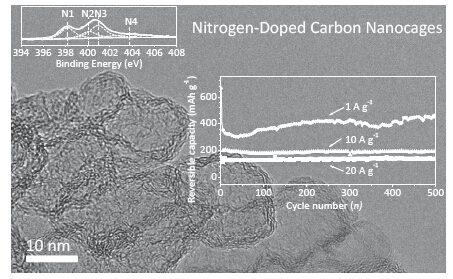| [1] Armand, M.; Tarascon, J. M. Nature 2008, 451, 652.
[2] Xu, Y.; Guo, J.; Wang, C. J. Mater. Chem. 2012, 22, 9562.
[3] Goodenough, J. B.; Park, K. S. J. Am. Chem. Soc. 2013, 135, 1167.
[4] Shen, L. F.; Uchaker, E.; Zhang, X. G.; Cao, G. Z. Adv. Mater. 2012, 24, 6502.
[5] Kang, B.; Ceder, G. Nature 2009, 458, 190.
[6] Wu, X. L.; Jiang, L. Y.; Cao, F. F.; Guo, Y. G.; Wan, L. J. Adv. Mater. 2009, 21, 2710.
[7] Wang, L.; He X, Sun W.; Wang, J.; Li, Y.; Fan, S. Nano Lett. 2012, 12, 5632.
[8] Ye, Y.; Zhu, J. Y.; Yao, Y. N.; Wang, Y. G.; Wu, P.; Tang, Y. W.; Zhou, Y. M.; Lu, T. H. Acta Chim. Sinica 2015, 73, 151. (叶亚, 朱婧怡, 姚依男, 王雨果, 吴平, 唐亚文, 周益明, 陆天虹, 化学学报, 2015, 73, 151.)
[9] Manthiram, A. J. Phys. Chem. Lett. 2011, 2, 176.
[10] Li, H.; Wang, Z. X.; Chen, L. Q.; Huang, X. J. Adv. Mater. 2009, 21, 4593.
[11] Zhu, G. N.; Liu, H. J.; Zhuang, J. H.; Wang, C. X.; Wang, Y. G.; Xia, Y. Y. Energy Environ. Sci. 2011, 4, 4016.
[12] Zhang, Y.; Hu, X.; Xu, Y.; Ding, M. Acta Chim. Sinica 2013, 71, 1341. (张永龙, 胡学步, 徐云兰, 丁明亮, 化学学报, 2013, 71, 1341.)
[13] Zhang, F. Ph.D. Dissertation, Jilin University, Jilin, 2009 (张峰, 博士论文, 吉林大学, 吉林, 2009).
[14] Ng, S. H.; Wang, J.; Guo, Z. P.; Chen, J.; Wang, G. X.; Liu, H. K. Electrochim. Acta 2005, 51, 23.
[15] Li, C. C.; Yin, X. M.; Chen, L. B.; Li, Q. H.; Wang, T. L. J. Phys. Chem. C 2009, 113, 13438.
[16] Han, F. D.; Yao, B.; Bai, Y. J. J. Phys. Chem. C 2011, 115, 8923.
[17] Wu, Z. S.; Ren, W.; Xu, L.; Xu, L.; Li, F.; Cheng, H. M. ACS Nano 2011, 5, 5463.
[18] Fang, Y.; Lv, Y.; Che, R.; Wu, H.; Zhang, X.; Gu, D.; Zheng, G.; Zhao, D. J. Am. Chem. Soc. 2013, 135, 1524.
[19] Yang, L. J.; Jiang, S. J.; Zhao, Y.; Zhu, L.; Chen, S.; Wang, X. Z.; Wu, Q.; Ma, J.; Ma, Y. W.; Hu, Z. Angew. Chem., Int. Ed. 2011, 50, 7132.
[20] Zhao, Y.; Yang, L. J.; Chen, S.; Wang, X. Z.; Ma, Y. W.; Wu, Q.; Jiang, Y.; Qian, W. J.; Hu, Z. J. Am. Chem. Soc. 2013, 135, 1201.
[21] Ma, Y. W.; Sun, L. Y.; Huang, W.; Zhang, L. R.; Zhao, J.; Fan, Q. L.; Huang, W. J. Phys. Chem. C 2011, 115, 24592.
[22] Long, Q.; Chen, W. M.; Wang, Z. H.; Shao, Q. G.; Li, X.; Yuan, L. X.; Hu, X. L.; Zhang, W. X.; Huang, Y. H. Adv. Mater. 2012, 24, 2047.
[23] Shin, W. H.; Jeong, H. M.; Kim, B. G.; Kang, J. K.; Choi, J. W. Nano Lett. 2012, 12, 2283.
[24] Xie, K.; Qin, X. T.; Wang, X. Z.; Wang, Y. N.; Tao, H. S.; Wu, Q.; Yang, L. J.; Hu, Z. Adv. Mater. 2012, 24, 347.
[25] Chen, S.; Bi, J. Y.; Zhao, Y.; Yang, L. J.; Zhang, C.; Ma, Y. W.; Wu, Q.; Wang, X. Z.; Hu, Z. Adv. Mater. 2012, 24, 5593.
[26] Feng, R.; Wang, L. W.; Lyu, Z. Y.; Wu, Q.; Yang, L. J.; Wang, X. Z.; Hu, Z. Acta Chim. Sinica 2014, 72, 653. (冯瑞, 王立伟, 吕之阳, 吴强, 杨立军, 王喜章, 胡征, 化学学报, 2014, 72, 653.)
[27] Kaskhedikar, N. A.; Maier, J. Adv. Mater. 2009, 21, 2664.
[28] Wen, L.; Liu, C. M.; Song, R. S.; Luo, H. Z.; Shi, Y.; Li, F.; Chen, H. M. Acta Chim. Sinica 2014, 72, 333. (闻雷, 刘成名, 宋仁升, 罗洪泽, 石颖, 李峰, 成会明, 化学学报, 2014, 72, 333.)
[29] Liu, N.; Hu, L.; McDowell, M. T.; Jackson, A.; Cui, Y. ACS Nano 2011, 5, 657.
[30] Hou, J. H.; Cao, C. B.; Idrees, F.; Ma, X. L. ACS Nano 2015, 9, 2556.
[31] Song, H. W.; Yang, G. Z.; Wang, C. X. ACS Appl. Mater. Interfaces 2014, 6, 21661.
[32] Wu, Z. S.; Ren, W.; Wen, L.; Gao, L.; Zhao, J. P.; Chen, Z. P.; Zhou, G. M.; Li, F.; Cheng, H. M. ACS Nano 2010, 4, 3187.
[33] Lyu, Z. Y.; Xu, D.; Yang, L. J.; Che, R. C.; Feng, R.; Zhao, J.; Li, Y.; Wu, Q.; Wang, X. Z.; Hu, Z. Nano Energy 2015, 12, 657. |
